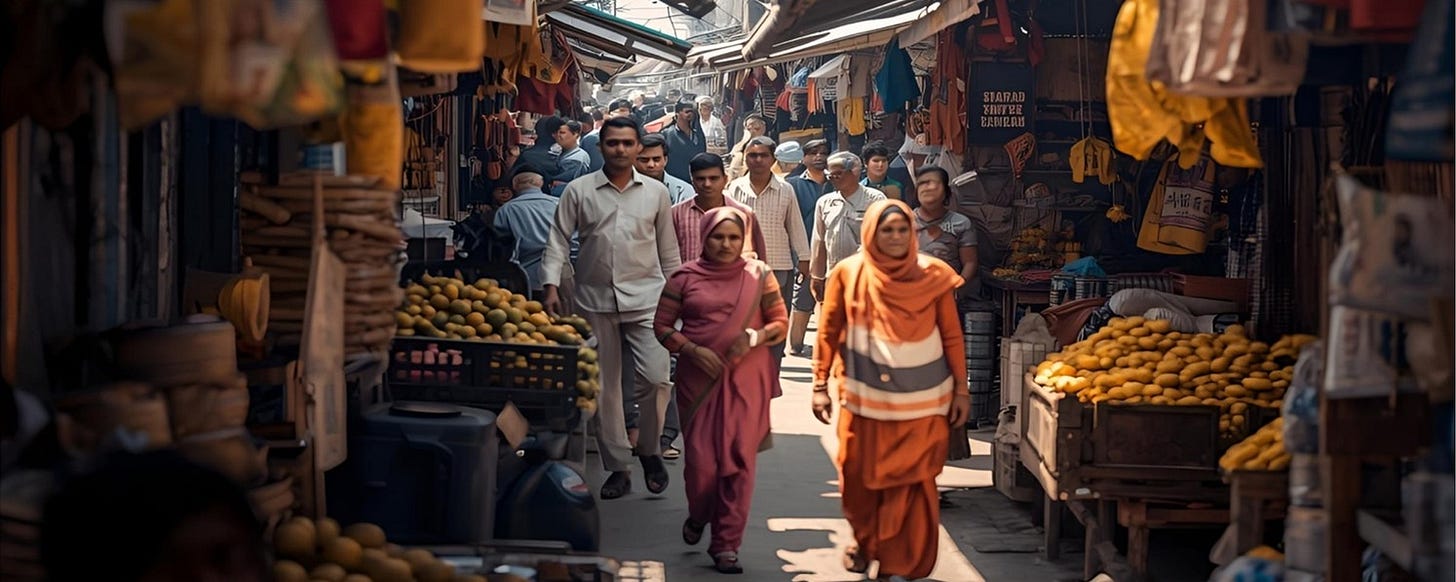India’s Informal Economy: Two Worlds, One Future
From village workshops to city stalls, informal work sustains millions. Smart policy could turn it into a source of resilience
View as PDF
Mehak Majeed: Islamic University of Science and Technology, Kashmir
Zahid Gulzar: Department of Higher Education J&K
SDG 8: Decent Work and Economic Growth | SDG 10: Reduced Inequalities
Institutions: Ministry of Labour and Employment | Ministry of MSMEs
India’s informal economy is not a footnote to development; it is the main story. More than four out of five workers earn their living outside formal employment, in activities ranging from home-based tailoring and small repair shops to street vending and transport services. Yet despite its scale, it remains largely invisible in the way policy is designed and resources are allocated.
That neglect reflects a long-standing assumption. For decades, economists treated informal work as a temporary stage, expected to vanish as modernisation drew people into factories and offices. India’s experience has proved otherwise. Informality has not withered away; it has adapted, expanded, and in many cases complemented the formal sector. The question is no longer whether informality will disappear, but how its two halves - rural and urban - can be strengthened to drive inclusive growth.
Scale and Diversity
The sheer numbers underline its significance. Official surveys, such as the National Sample Survey (NSS) on Unincorporated Non-Agricultural Enterprises, suggest the informal sector employs more than 80 percent of India’s workforce and contributes nearly half of national output. Far from being marginal, it is the country’s economic backbone. Yet it is not one economy but many.
Rural and urban realities diverge sharply. In villages, 37 percent of enterprises operate from household premises, compared with 27 percent in cities. The overlap between family and work is a defining feature of rural informality. In urban areas, density and competition push enterprises into dedicated commercial spaces.
Ownership patterns also reveal stubborn inequalities. More than 82 percent of enterprises are male-owned, while women account for only 12-13 percent. Transgender ownership barely registers, at 0.1 percent in rural areas and 0.2 percent in urban ones. Collective structures such as self-help groups (SHGs), which could allow small producers to pool resources and strengthen bargaining power, remain scarce.
Enterprise type also varies. Rural economies are dominated by “own-account enterprises” – family-run ventures without hired labour – accounting for 62 percent of rural units compared with 51 percent in cities. Urban firms are more likely to employ others, but this often results in precarious jobs with low wages and little security.
Productivity Gaps across Rural and Urban India
The rural–urban divide shows up most clearly in productivity. On average, informal firms in cities produce more with the same inputs than their rural counterparts. One striking figure illustrates the gap: rural units operate at about 31 percent efficiency, while urban ones reach nearly 48 percent.
The reasons are structural. Urban firms have easier access to tools, machinery, and markets. They operate year-round, avoiding the seasonal fluctuations that drag down efficiency in rural units. Rural enterprises rely heavily on family labour, often drawing on skills honed during agricultural off-seasons, but lack capital. Where rural firms gain some advantage is in reinvesting farm earnings into small businesses, which helps offset their limited access to credit.
Technology reflects another divide. In cities, computer use improves efficiency by widening markets and streamlining transactions. In rural areas, however, computers have sometimes reduced efficiency because training and digital literacy lag behind. The lesson is clear: infrastructure alone is not enough - technology without capacity-building risks widening the gap.
Migration Pressures and Missed Inclusion
These economic differences spill into broader social pressures. Shrinking opportunities in agriculture drive workers to cities, but urban informal markets - street vending, construction, casual services - are already saturated. Migration often results in underemployment, not prosperity. Strengthening rural enterprises would ease this pressure, making migration a matter of choice rather than a necessity.
Gender disparities are another persistent constraint. Women remain underrepresented as proprietors, and when they do participate, their enterprises are smaller and less profitable. Yet greater female involvement is associated with better household welfare and reduced poverty.
Why Support Misses Informal India
The informal sector sustains livelihoods for the majority, but remains marked by low efficiency, uneven support, and sharp social gaps. These weaknesses reflect inconsistent policy attention.
Credit remains a major barrier. Rural enterprises depend heavily on moneylenders charging crippling rates, while urban firms borrow from banks under repayment schedules that rarely match their irregular cash flows. Both systems trap enterprises in cycles of debt and underinvestment.
Labour protections are equally thin. Most informal workers lack contracts, pensions, or healthcare coverage. Urban establishments that employ casual labour are especially vulnerable, as competitive pressures drive down wages and safety standards.
Even government assistance has had uneven results. NSS data, covering more than 141,000 enterprises, suggest support programmes often improve efficiency in urban firms but have weaker, or even negative, impacts in rural ones. Without tailored design, such policies risk deepening inequality.
Turning Informality into Strength
The challenge is not the existence of informality but the mismatch between its realities and the policies meant to support it. A deliberate strategy is needed to strengthen both sides of the informal economy - rural and urban - in ways that reflect their distinct needs.
In urban enterprises, basic labour protections should be extended in forms suited to small enterprises, ensuring fair wages and safer conditions without burdening them with rules designed for large factories.
In rural enterprises, where family-run and one-person units dominate, encouraging entrepreneurship is important. Supporting them with incubation, mentoring, and targeted subsidies could help shift them from subsistence to stability. Building stronger SHGs and cooperatives would allow workers to share risks, invest collectively, and strengthen bargaining power.
Credit reform is critical for both rural and urban firms, though in different ways: rural enterprises must be freed from moneylenders, while urban ones need loans with repayment schedules that match irregular cash flows. A dedicated credit system with modest loan sizes and flexible terms would help unlock investment everywhere.
Digital inclusion is another shared need. In cities it can expand markets, while in villages it must first be paired with training so that technology enhances rather than undermines efficiency.
Finally, better evidence is needed. The most comprehensive national survey dates back to 2015-16. For a sector employing the vast majority of India’s workforce, this is outdated. Regular surveys would allow policymakers to track changes, measure outcomes, and refine interventions with greater accuracy.
The Way Forward
India’s informal economy is not a relic of backwardness; it is a living part of the nation’s economic fabric. Its future will not be written only in glass towers and industrial parks but also in workshops, market stalls, and household ventures that sustain millions. With half of informal enterprises rural and half urban, ignoring either weakens the whole. Recognising and investing in this reality is not a dead weight – it is sound economics.
With the right mix of support and protection, the informal economy can move from being India’s invisible backbone to its most visible driver of inclusive prosperity.
View as PDF
Authors:

The discussion in this article is based on the authors’ research published in the Journal of Quantitative Economics (2025). Views are personal.


